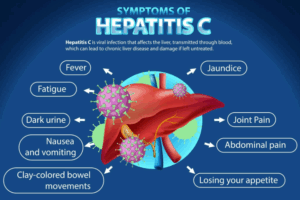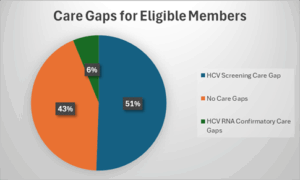Transforming Hepatitis C Management Through Innovation
Monique Dodd, PharmD
July 28, 2025
 Throughout the US, New Mexico has one of the highest rates of hepatitis C virus (HCV) infection. Roughly 2.8% of the state’s population are living with chronic HCV, with many cases currently undiagnosed. TriCore’s innovative use of longitudinal laboratory data and analytics has led to the creation of an HCV targeted intervention algorithm for the identification and monitoring of individuals with HCV in New Mexico.
Throughout the US, New Mexico has one of the highest rates of hepatitis C virus (HCV) infection. Roughly 2.8% of the state’s population are living with chronic HCV, with many cases currently undiagnosed. TriCore’s innovative use of longitudinal laboratory data and analytics has led to the creation of an HCV targeted intervention algorithm for the identification and monitoring of individuals with HCV in New Mexico.
What is the HCV Targeted Intervention Algorithm?
The aim of a clinical decision support tool is to provide efficient access to actionable insights that support informed decisions, close care gaps and improve patient outcomes. The HCV targeted intervention algorithm was designed with that very purpose in mind. The HCV algorithm is a dynamic network of standardized, cross-mapped codes, continuously fed by streams of longitudinal laboratory data. Like assembling a clinical mosaic, the algorithm transforms disparate data points from multiple systems into a structured, relevant patient history. It is designed to capture what matters most to guide timely, informed patient care. The clinical insights generated by the algorithm are built on evidence-based guidelines and informed by clinical practice in communities across New Mexico. The identification of care gaps and risk stratification are at the core of the algorithm, transforming data into actionable insights within a patient summary report or interactive dashboard.
Population and Patient Level Insights
Innovative clinical targeted interventions, such as those created by the HCV algorithm, enable end-users to focus on either a population-level view or an individual patient view. Whether the end-user is a clinic-based provider, an epidemiologist with the department of health, or a care coordinator with an insurance group, tools developed from the HCV algorithm are designed to support diverse clinical workflows. Figure 1 is an example of population-level insights that can be used by care coordinators to facilitate resources for closing gaps in care. They can also use this information to identify the 51% of members with HCV screening care gaps and proactively intervene by linking these members to care. Turning these insights into action requires a coordinated collaboration among providers, payers, laboratories, and public health partners.

Figure 1: Members who meet the HCV care gaps criteria.
Collaboration
Limited interoperability of clinical data and the overwhelming volume of data across healthcare delivery systems pose significant barriers to timely and effective patient care. Through collaboration with payers, providers and New Mexico’s health information exchange (HIE), TriCore’s HCV algorithm has come to life. Today, access to the HCV patient summary tool or the dashboard insights are now at the fingertips of providers and payers across New Mexico through secure portals or even directly within the electronic health record (EHR). These tools transform fragmented HCV-related data into meaningful clinical insights that enhance care coordination and streamline workflows, ultimately supporting the identification, treatment, and elimination of HCV in our communities. These partnerships demonstrate how alignment in strategic goals and the integration of data infrastructures can drive innovation in public health and patient care.
Recognizing that New Mexico is part of a national strategy to eliminate HCV by 2030, TriCore is leveraging lab domain knowledge, longitudinal laboratory data and technology platforms to develop targeted interventions for closing care gaps and stratify risk in patients with HCV. Through continued collaborations and data-driven innovations, TriCore is helping pave the way towards eliminating HCV in New Mexico.